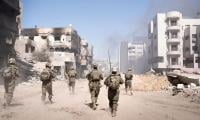Russia invaded Ukraine on February 20, 2022 and since then the intensity and scope of its military operation have been faltering. Vladimir Kvachkov, a retired Russian colonel who was released from prison in 2019 and who recently resumed his political career, argues that “the course and outcome of a special military operation (SMO) are directly related to military-political goals and objectives.”
The declared goal of the Russian SMO in Ukraine is the demilitarization and denazification of Ukraine. While little success has been achieved from this military operation, there are three important steps that Russia took recently, which demonstrate the rationality and prudence of Russian President Vladimir Putin’s military strategy while simultaneously driving the current conflict to becoming a long protracted war in 2023. These steps include recurrent retreats, new state-of-emergency laws introduced in October 2022 and the appointment of a new commander in Ukraine.
The Ukrainian forces have successfully driven the Russian army out of Kyiv, Kharkiv and Kherson so far. Kherson was the first regional capital that the Russian forces captured and it was celebrated with Putin’s declaration that Kherson would be Russia ‘forever’. Eventually, Russia had to withdraw as its forces became overstretched, undersupplied and extensively exposed to the Ukrainian forces. Earlier, the Kyiv counteroffensive rattled Russian military operations resulting in the forces’ withdrawal from the city in March 2022.
Even though this defeat was a major blow to Putin’s goal of regime change and signified his poor military campaign, Russian Deputy Defence Minister Alexander Fomin described it as a move aimed at “increasing mutual trust, creating the right conditions for future negotiations, and reaching the final goal of signing a peace deal with Ukraine”, during peace talks in Istanbul.
These withdrawals have given Russia some time to rebuild its combat-ready force. The Kherson withdrawal may allow Russia to move its troops to the more advantageous defensive positions on the east bank of the Dnipro River, difficult for the Ukrainian forces to penetrate because they effectively damaged the major bridges over the river as part of their military operations. But they can also shift the Ukrainian forces closer to Crimea that Russia annexed in 2014. Kyiv now vows to have no negotiations with the Kremlin until the Russian forces leave Crimea.
To tackle harsh temperatures of the winter, Russia’s retreat and shift to defensive positions is a prudent decision to control wartime losses. Many Russians are now tired of the war. Under these circumstances, any reductions in losses as a result of the withdrawal will be welcomed by the Russian nation. The recurrent retreats also indicate Russia’s willingness to cede space for concessions, which is a rational pragmatic approach.
Previously, the Kherson retreat could minimize, to a smaller extent, the international ire that drew heavily upon Putin after he announced martial law in four annexed Ukrainian provinces. The new state-of-emergency laws introduced in October provided the heads of the four Ukrainian provinces – Luhansk, Zaporizhzhia, Donetsk and Kherson – along with the heads of the provinces of Crimea and Sevastopol powers to maintain law and order and increase production to support Russian military campaigns in Ukraine.
The enactment of these laws include a pinch of prudence as they aim to strategically defend captured objectives in terms of annexed provinces instead of expanding the geographical scope of war. Simultaneously, economic mobilization in those regions is crucial to support the Russian war effort.
Undoubtedly, the Russian forces have suffered a series of crushing defeats leading to reverses from southern and north-eastern Ukraine that raised questions about military preparedness and battlefield command. The wartime losses for Moscow were enormous, resulting in widespread criticism within Russia. Unable to withstand Ukrainian counteroffensive, the withdrawal from Kyiv and Kharkiv was made but it upset the Russian ruling class. To pacify criticism especially within the Russian elite on Russian military performance, the change in war command is a step in the right direction, primarily due to the new general’s reportedly high reputation and wider acceptance within the system.
The appointment of General Sergei Surovikin in October 2022 as the “commander of the joint group of forces in the areas of the special military operation” is seen as a rational development in Russian strategy. Ben Barry, a senior fellow for land warfare at the International Institute for Strategic Studies in London, reportedly notes this new development as an element of ‘realism’ and believes that Russia can prepare for a fresh offensive to take initiative.
The joint command under Surovikin is thought to unite dispersed autonomous army groups under one. Previously, the new commander warned against holding Kherson for long. The Russians forces had been struggling to keep the area under control. Surovikin’s recent withdrawal from Kherson suggests a shift in his strategy to build a strong defence of the territories Moscow has captured so as to avoid relocation and repositioning of borders. Clearly, Russia is shifting to defensive warfare.
Putin launched a major SMO to protect Russians living in Donetsk and Luhansk, the south-eastern regions of Ukraine, and eliminate any threats to Russian security in the shortest time, but Ukrainian counteroffensive, supported by its allies, changed the course of Russian operation characterized by escalations and recurrent Russian retreats, indicating the SMO’s failure. The Russian SMO does not prove to be below the level of war given the destruction it caused in Ukraine as well as to Russian troops. It is clearly a war now. However, declaring it a war would mean involving the wider engagement of military capabilities and goals.
More so, the world witnessed a great deal of learning on the part of Russia since February. At that time, Putin vowed to demilitarize and denazify the whole of Ukraine and overthrow the Kyiv regime. However, the ferocity and high morale with which Ukrainians fought back along with allies’ assistance baffled the Russian SMO that was aimed at a swift decisive victory. Therefore, learning in terms of recurrent retreats, change in war command and state-of-emergency laws tend to bring in the Kremlin’s rational mind to its military campaign.
The re-grouping of its forces aims at defending annexed Crimea and the land corridor connecting it with Russia and providing Crimean access to Ukrainian waters. The latest Russian steps to revise its military strategy indicate the country’s tilt towards a tedious protracted war in 2023, but hopes are there for a rational Putin to reign in.
The writer is a London-based writer and teaches at King’s College
London. She can be reached at: shaheensalma7@gmail.com
A representational image showing residents walking at a wholesale market in Karachi. — AFP/FileOnce again there is...
A representational image showing late Pakistani human rights activist and Supreme Court lawyer Asma Jahangir. —...
A representational image showing a security personnel sanding guard beside a ship carrying containers at Gwadar port....
A health worker administers polio vaccine drops to a child during a door-to-door polio vaccination campaign in Lahore,...
Armed militants of the banned Tehreek-e-Taliban Pakistan pose for a photograph in Orakzai Agency. —...
An aeroplane of the national flag carrier of Pakistan is seen in this file photo. — AFPWhile Pakistan considers...







